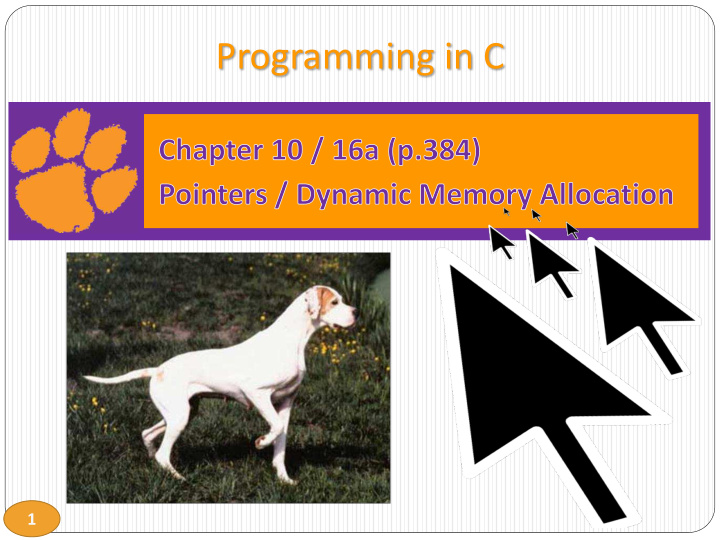



Programming in C 1
Pointer Variable A variable that stores a memory address Allows C programs to simulate call-by-reference Allows a programmer to create and manipulate dynamic data structures Must be defined before it can be used Should be initialized to NULL or valid address 2
Declaring Pointers Declaration of pointers <type> *variable <type> *variable = initial-value Examples: 3
Pointers A pointer variable has two associated values: Direct value address of another memory cell Referenced by using the variable name Indirect value value of the memory cell whose address is the pointer's direct value. Referenced by using the indirection operator * 4
Pointer Operators Come before a variable name * operator Indirection operator or dereferencing operator Returns a synonym, alias or nickname to which its operand points & operator Address of operator Returns the address of its operand 5
Pointer Variables One way to store a value in a pointer variable is to use the & operator The address of count is stored in countPtr We say, countPtr points to count 6
Pointer Variables Assume count will be stored in memory at location 700 and countPtr will be stored at location 300 causes 5 to be stored in count causes the address of count to be stored in countPtr 7
Pointer Variables We represent this graphically as 8
Pointer Variables The indirection / dereferencing operator is * stores the value 10 in the address pointed to by countPtr 9
Pointer Variables The character * is used in two ways: To declare that a variable is a pointer 1. Pre-pending a variable with a * in a declaration declares that the variable will be a pointer to the indicated type instead of a regular variable of that type To access the location pointed to by a pointer 2. Pre-pending a variable with a * in an expression indicates the value in the location pointed to by the address stored in the variable 10
Simulating By Reference Invoked function uses * in formal parameters Invoking function uses & in actual parameters 11
Pointer Variables and Arrays Given The compiler will know how many bytes to copy into the memory location pointed to by xPtr Defining the type that the pointer points to permits a number of other interesting ways a compiler can interpret code 12
Pointer Variables and Arrays Consider a block in memory consisting of ten integers of 4 bytes in a row at location 100 10 Now, let's say we point an integer pointer aPtr at the first of these integers What happens when we write ? 13
Pointer Variables and Arrays Because the compiler "knows" This is a pointer (i.e. its value is an address) That it points to an integer of length 4 at location 100 Instead of 1, adds 4 to aPtr Now aPtr "points to" the next integer at location 104 Same for: aPtr+=1, aPtr++, and ++aPtr 14
Pointer Variables and Arrays Since a block of 10 integers located contiguously in memory is, by definition, an array of integers, this brings up an interesting relationship between arrays and pointers 15
Pointer Variables and Arrays Consider this array allocated at location 200 We have an array containing 10 integers We refer to each of these integers by means of a subscript to scores Using scores[0] through scores[9] 16
Pointer Variables and Arrays The name of an array and the address of the first element in the array represent the same thing Consequently, we could alternatively access them via a pointer: 17
Pointer Variables and Arrays The name of an array is a pointer constant to the first element of the array So, we could also use : 18
Pointer Arithmetic and Arrays If scorePtr is pointing to a specific element in the array and n is an integer, scorePtr + n is the pointer value n elements away We can access elements of the array either using the array notation or pointer notation If scorePtr points to the first element, the following two expressions are equivalent: scores[n] Array notation *(scorePtr + n) Pointer notation 19
Pointers and Dynamic Allocation of Memory So far, we have always allocated memory for variables that are located on the stack Size of such variables must be known at compile time Sometimes convenient to allocate memory at run time System maintains a second storage area called the heap Functions calloc and malloc allocate memory as needed of size needed 20
Pointers and Dynamic Allocation of Memory Use allocating function (such as malloc() , 1. calloc() , etc.) Returns void pointer void * indicates a pointer to untyped memory Will have to cast the returned value to the specific type needed Use memory through the pointer notation 2. Release allocated space when no longer needed, 3. so that it can be reused 21
Pointers and Dynamic Allocation of Memory: calloc calloc Used to dynamically create an array in the heap Contiguous allocation Initialized to binary zeros Must Takes two arguments Number of array elements 1. Amount of memory required for one element 2. Use sizeof function / operator Returns Void pointer if successful NULL if unsuccessful 22
Pointers and Dynamic Allocation of Memory: calloc Example 1: String Example 2: Integers 23
Pointers and Dynamic Allocation of Memory: malloc malloc Used to dynamically get memory from heap Contiguous allocation No initialization Must Takes one argument Total amount of memory required Returns Void pointer if successful NULL if unsuccessful 24
Pointers and Dynamic Allocation of Memory: malloc Example 1: String Example 2: Integers 25
Pointers and Dynamic Allocation of Memory: free free Used to dynamically release memory back to heap Contiguous deallocation Must Takes one argument Pointer to beginning of allocated memory Good idea to also NULL pointer if reusing 26
Pointers and Dynamic Allocation of Memory: free Example 2 with free 27
Programming in C T H E T H E E N D N D 28
Recommend
More recommend